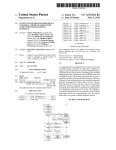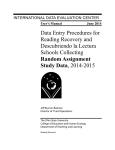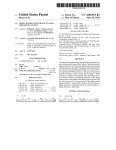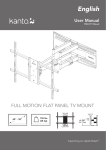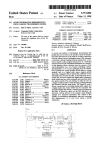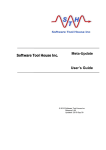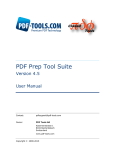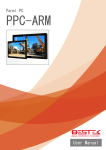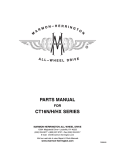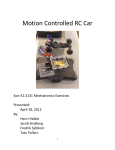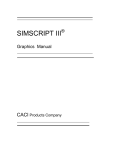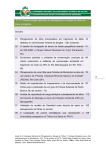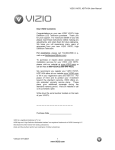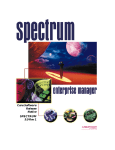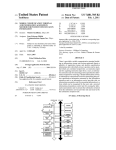Download Customizing forms in an electronic mail system utilizing custom field
Transcript
US007051273B1 (12) United States Patent (10) Patent N0.: Holt et a]. (54) (45) Date of Patent: 4,481,603 A ELECTRONIC MAIL SYSTEM UTILIZING 4,651,288 A 3/1987 Zeising ........... .. CUSTOM FIELD BEHAVIORS AND USER 4,807,155 A 2/1989 Cree et a1. DEFINED OPERATIONS 4,831,526 A * 4,884,217 A Nick H019 Seattle’ WA (Us); Steve 3135133? 2‘ Thomas’ Redmond’ WA (Us) 4,939,689 A _ (*) *May 23, 2006 CUSTOMIZING FORMS IN AN <75) (73) US 7,051,273 B1 4,970,665 A Asslgneei Microsoft Corporation, Redmond, WA Notice: 11/1984 McCaskill et a1. ........ .. 707/507 5/1989 11/1989 .. 358/1.18 345/329 Luchs ct a1. .... .. 707/530 Skeirik et a1. .............. .. 706/56 ‘51338 15532121,? i‘fjj. ' ' ' ' ' 3794535251 7/1990 Davis et a1. 11/1990 Doi et a1. ........... .. 707/102 707/523 5,021,973 A * 6/1991 Hernandez et a1. 715/504 (Us) 5,033,009 A 7/1991 707/503 Subject to any disclaimer, the term ofthis 5,060,980 A * 10/1991 Johnson et a1. 283/70 5,091,868 A * 2/1992 Pickens et a1. ........... .. 707/506 Dubnoif ............ .. patent is extended or adjusted under 35 USC 154(b) by 0 days. (Continued) This patent is subject to a terminal dis- OTHER PUBLICATIONS Clalmer' Morris, James H. Et al., Andrew: a distributed personal com utin environment, Communications of the ACM, vol. (21) Appl' No‘ 08/938’468 (22) Filed: 29, 1pssiieg3, pp. 184-201, Mar. 1986* Aug. 14, 1996 (Continued) (63) Related U's' Apphcatlon Data Continuation of application No. 08/334,616, ?led on Primary ExamineriWilliam Bashore (74) Attorney, Agent, or FirmiWorkman Nydegger Nov. 3, 1994, noW Pat. No. 5,557,723, Which is a continuation of application No. 08/207,231, ?led on (57) ABSTRACT Mar. 7, 1994, noW abandoned, Which is a continuation ofapplication No. 07/621 ,444, ?led on Nov. 30, 1990, noW abandoned. (51) User-customizable forms in an electronic mail system enable an administrator to select customized ?eld types and IIlt- ClG06F 15/00 (2006-01) G06F 17/00 (2006-01) customized behaviors. The electronic mail system provides for the receiving and displaying of mail information in conjunction With the use of a user-customizable form. An (52) US. Cl. .................... .. (58) Field of Classi?cation Search .............. .. 707/505, ?eld types and a behavior from among multiple behaviors 707/530; 507; 506; 520; 5011; 712/1; 345/347; 345/333; 809; 283/70; 7155034508; 500 See application ?le for complete Search history' When data is entered by a user to the customized ?eld having the selected ?eld type, the selected behavior is applied 10 the data. In this manner, the administrator has the ?exibility of creating a variety of customized forms in the electronic mail system, and is not limited to a relatively small number of prede?ned forms. (56) 715/506; 715/505; 715/507; administrator creates a customized ?eld of a customized 715/ 508 form by selecting a ?eld type from a among multiple de?ned References Cited U.S. PATENT DOCUMENTS 4,403,301 A 20 Claims, 14 Drawing Sheets 9/1983 Fessel a. US 7,051,273 B1 Page 2 US. PATENT DOCUMENTS 5,105,355 A 5,119,476 4/1992 Yoshida et al. ........... .. 707/531 A 6/1992 Texier . . . . . . . . . . . . . . . . . . .. 345/347 5,121,499 A * 6/1992 McCaskill et al. 5,140,676 A 5,144,555 A 8/1992 Langelaan ................ .. 707/515 9/1992 Takadachi et al. ........ .. 707/530 5,144,693 9/1992 A 5,182,705 A 5,208,906 A A . . . . . . . . . . . . . . . . .. 1/1993 Barr et al. * 5,222,211 A 5,404,294 Morgan 715/503 5/1993 Morgan ... ... .. .. 705/11 . . . .. 6/1993 Mueller et a1. . * 4/1995 Karnik . ... .. .. 5,745,712 A * 4/1998 Turpin et a1. 5,862,395 A * 1/1999 345/342 707/520 707/506 . . . .. 707/507 345/333 Bier ............................ .. 712/1 OTHER PUBLICATIONS Miller, Michael 1., PerForm Pro de?nes the state of the art in forms packages, InfoWorld, V01. 12, No. 39, Sep. 24, 1990, p. 88* LitWin, Paul, Looking Good: the complete guide to enhanc ing your forms!, Data Based Advisor, V01. 8, No. 9, Oct. 1990, pp. 66-72.* Getting Started With Microsoft Excel Version 2.2, 1989 Microsoft Corporation, pp. 5-19.* Dayton, Doug, PerForm Pro expands simple WYSIWYG form design, ?lling, PC Week, V01. 7, No. 39, Oct. 1, 1990, pp. 33-35.* Creating and Managing the Business Form Electronically, The O?ice, Stamford, Nov. 1986, Vol. 104, Issue 5, p. 1-5.* Goodman, Danny, The Complete HyperCard Handbook, Sep. 1987, Bantam Books, Inc. pp. 56-63, 85-183.* Kovac, C. “E-mail Streamlines Paper Giant,” Communica tions News V01. 25, No. 9, Sep. 1988, pp. 42(2). Acerson, WordPerfect: The Complete Reference, Series 5 Edition, McGraW-Hill, 1988, pp. 1091-1124. Think Technologies, Inc., InBox Desktop Communications Software User’s Guide, 1986, pp. 1-1 through 4-9, and I-1 through I-9. Lund, Luke and Bill Davis, QM FormsTM for Apple® Macintosh® Third Edition, CE SoftWare, Inc., 1989, pp. 1-17. Lund, Luke, QuickMailTM User Manual for Apple® Macintosh® Computers, Third Edition, CE Software, Inc., 1988, pp. 23 and 38. * cited by examiner U.S. Patent May 23, 2006 Sheet 1 0f 14 US 7,051,273 B1 9 .@ Q9 E A @ 3 2 @ . ‘ 8 v : 6 1 5 . , 2 : 3 UmsmHacngmo: sD;.I,_E=L Q@[email protected]:E26 mamE=2.9@6 6.r: _&AvE2m5:5a: E3231325. \Xmi U.S. Patent May 23, 2006 Sheet 2 0f 14 US 7,051,273 B1 Trial 20 7. ~ SgnJ/FMVQ 8M1 Call FcP Form Mu swim 205 U.S. Patent May 23, 2006 Sheet 3 0f 14 US 7,051,273 B1 / EC] 3 0;’ 5’ Send Screen To: E] “s “dress Library Request ____ _ z 0 % ’“[ Subject [ I "30! Sources: Delivery; [:1 Journals E] Reference books C] Date services U ManuaTs 0 Pick up O Inter-office [1] Enclosure; @ / 3 6K j 30¢ 367 J 3” ? U.S. Patent May 23, 2006 Sheet 4 0f 14 F'OQY“ LAYOUT “FHDTd' "F'FLDH idevd‘ 'i Fwl HAN‘ “FFLD” I‘ Jewi Fla! FM Half idem)? ‘FDA?’ HA HAY‘ “FFQZ' Fig“ 4f US 7,051,273 B1 U.S. Patent May 23, 2006 @ Sheet 5 0f 14 US 7,051,273 B1 PM 0\ Grail Wham)” 0", on P1P I — iiléreiakgeidl. 5 "CA" PM. 0, 'cm PCP 51w {wQagt/ . ‘IQ-1119M’! . {31 WW é‘lifi-SFQ’EEED U.S. Patent May 23, 2006 FCPr u .1’ Sheet 6 0f 14 re?ned’ ‘Field, f M 0I US 7,051,273 B1 U.S. Patent May 23, 2006 Sheet 7 0f 14 US 7,051,273 B1 U.S. Patent May 23, 2006 Sheet 8 0f 14 @ 0/4/914 Call FCPre an...‘ reg/duff“ " Farm Cut l ‘am; m, 07/ GM“. . (all RP” .6; 1117C??? Fm ( Qdéun) ) O - US 7,051,273 B1 U.S. Patent May 23, 2006 Sheet 10 0f 14 US 7,051,273 B1 (all FcPr m“ U.S. Patent May 23, 2006 Sheet 11 0f 14 US 7,051,273 B1 of Edwin)? U.S. Patent May 23, 2006 Sheet 12 0f 14 US 7,051,273 B1 FW? U.S. Patent May 23, 2006 @ .___..____.... I Sheet 13 0f 14 FW 0 / - _ US 7,051,273 B1 _ _. ._ _- ____ \3 U.S. Patent May 23, 2006 Sheet 14 0f 14 US 7,051,273 B1 F (60%" L/ 0.3 504 “ *7 ob Y“ d sdglw - vi-wiwner US 7,051,273 B1 1 2 CUSTOMIZING FORMS IN AN ELECTRONIC MAIL SYSTEM UTILIZING CUSTOM FIELD BEHAVIORS AND USER DEFINED OPERATIONS SUMMARY OF THE INVENTION It is an object of the present invention to provide a method and system for customiZing forms in an electronic mail system. It is another object of the present invention to provide an electronic mail system in Which the user of the mail system can specify the ?eld layout of a custom form and specify the behavior of the ?elds in the custom form. It is another object of this invention to provide an elec tronic mail system that collects data through a custom form, packs the data into a mail message, and transports the mail CROSS-REFERENCE TO RELATED APPLICATIONS This application is a continuation of US. patent applica tion Ser. No. 08/334,616, ?led Nov. 3, 1994 now US. Pat. No. 5,557,723, Which is a continuation of US. patent application Ser. No. 08/207,231, ?led Mar. 7, 1994 noW abandoned, Which is a continuation of US. patent applica tion Ser. No. 07/621,444, ?led Nov. 30, 1990 noW aban doned. message to the speci?ed recipients of the mail. It is another object of this invention to provide an elec tronic mail system that receives mail messages, unpacks the data from the mail message, and displays the data in a custom form. It is another object of the present invention to provide an TECHNICAL FIELD This invention relates to an improved method and system 20 electronic mail system With a transaction event processor to receive mail events and to call a form control procedure to implement the behavior of the custom form. It is another object of the present invention to provide a layout for a form data structure that includes the de?nition of the form ?elds and the form control procedure. for communicating information through electronic mail sys tem and in particular a method and system of using cus tomiZable forms in an electronic mail system. 25 BACKGROUND OF THE INVENTION BRIEF DESCRIPTION OF THE DRAWINGS FIG. 1 shoWs an example of a typical send message form. FIG. 2 shoWs the components of a mail system that It is common in Written communications to use standard forms. Examples of standard forms are credit application and phone message slips. These forms alloW for the collec 30 implements custom forms. tion of certain data in a structured format. This structured FIG. 3 shoWs an example of a custom form. format simpli?es the processing of the data. In computer systems, data is often gathered and displayed FIG. 4 shoWs the layout of the form data structure. through the use of electronic forms. For example, a com puter program could display a form that looks similar to the paper version of a credit application form. This similarity 35 simpli?es the entry of data into the computer and subsequent display of the data. An electronic mail system alloWs mail to be collected electronically through a computer terminal and transmitted 40 to another computer or another user of the same computer FIG. FIG. FIG. FIG. FIG. FIG. FIG. FIG. FIG. FIG. 5 is a How diagram of the main routine of the TREV. 6 is a How diagram of subroutine FCPrequest. 7 is a How diagram of subroutine MouseEvent. 8 is a How diagram of subroutine CurrentField. 9 is a How diagram of subroutine KeyboardEvent. 10 is a How diagram of subroutine Enable/Disable. 11 is a How diagram of subroutine PackEvent. 12 is a How diagram of subroutine FCP. 13 is a How diagram of subroutine formNeW. 14 is a How diagram of subroutine ?eldPre. and displayed on a terminal. Typical mail systems use certain standard forms. For example, the standard send message form 100 as shoWn in FIG. 1 has a to ?eld 101 into Which the user enters the recipient of the mail messages and a re ?eld 102 into Which the user enters the subject of the mail. The send message form 100 also has text ?eld 103 into Which the user enters the body of the message. Amail system Would typically have an analogous receive message form for displaying a message. A feW mail systems have alloWed the user to add custom 45 In a preferred embodiment of the present invention, an electronic mail system implements user-customiZable forms 50 forms. These mail systems provide only limited customiZa tion. The customization is typically limited to the use of prede?ned components. For example, the forms designer 55 could specify Where to place a text ?eld or a date ?eld. HoWever, the mail system prede?nes hoW the ?elds Will operate. When a user of a form presses a key or uses a mouse button to click on a component of a form, the mail system Will typically take one or more actions in response to that input. The actions taken When a button ?eld is clicked, for example, is referred to as the “behavior” of the button. Each form component in custom forms traditionally has a single behavior or a ?xed number of possible prede?ned behaviors. While this limited customiZation alloWs for some degree of user-customization of electronic mail forms, the user is limited to the prede?ned components and behaviors. DETAILED DESCRIPTION OF THE INVENTION 60 65 that alloW the user to de?ne form components and their behavior. This invention alloWs a user to specify the layout of a custom form and specify a form control procedure (FCP) to control the behavior of the form components. The FCP is a computer subroutine that implements user-de?ned processing of the form. The form is de?ned in a form data structure that contains the layout of the form and the PCP. The mail system interacts With the PCP to collect form data and transmit the data to a receiver. The mail system also interacts With the PCP to display the message through the custom form When it is received. In a preferred embodiment, the mail system has a trans action event manager (TREV) that calls the PCP. The TREV creates a WindoW for the form and displays the form in the WindoW. When certain events occur, such as keyboard entry, for the WindoW, the TREV calls the PCP. This calling alloWs the PCP to perform custom processing. FIG. 2 shoWs the components of a mail system that uses custom forms. The mail system 201 contains the TREV 202. US 7,051,273 B1 3 4 The TREV accesses the form data structure 203 to display be placed at the bottom of the screen. The variable form Flags is set to the value ?NoMaillcon to indicate that the mail icon is not to be draWn oh the title bar. The variable formFlags is set to the value ?Modal to indicate that the WindoW is modal. The variable formFlags is set to the value lfGoAWay to indicate that the WindoW has not go aWay box. the form WindoW 204. The mail system 201 receives input from the keyboard 205 and mouse 206. The mail system 201 packs the message data into mail message format and transports the message to the recipient via electronic mail link 207. The mail system 201 also receives mail messages via electronic mail link 207 and unpacks the messages. The variable formProcld speci?es the style of WindoW. In FIG. 3 shoWs an example of a custom mail message form. a preferred embodiment the style can be modeless or modal. The form 300 is designed to handle library requests. The form 300 contains picture 301 that is suggestive of the The variable formCoords speci?es the screen position and siZe of the form WindoW. This positioning information can function, ?eld 302 that is a scroll list in Which the user overridden by the setting of variable formFlags. The variable formCurField is used internally by the TREV selects the recipient’s names, subject ?eld 303 Which is a text ?eld, request ?eld 304 Which is a scrolling text ?eld, check boxes 305 Which select the source, other ?eld 306 Which is a text ?eld, radio button ?elds 307 Which select the delivery means, and send button ?eld 308 Which alloWs the to store What ?eld is current. The variable formTitle is a string that is displayed in the title bar of modeless form WindoWs. Field Objects A form consists of a number of ?elds. Each ?eld object describes the characteristics of a ?eld of the form. For each ?eld there is one ?eld object in the form data structure. The user to indicate that the message is to be sent. Form Data Structure A custom form is de?ned in a form data structure. The form data structure describes the design and layout of the form. It describes the initial siZe of the form and initial placement of the form on the display. It describes the placement of prede?ned form components, such as buttons and text ?elds, and the placement and appearance of user de?ned form components. The appearance of user-de?ned form components may be de?ned as an arbitrary bitmap image. FIG. 4 shoWs the layout of the form data structure of a preferred embodiment. The form comprises four types of elements: form header, ?eld object, form control, and form control procedure. In a preferred embodiment, the elements 20 identi?er Would be a descriptive of the ?eld. For example, an address ?eld may have a secondary key equal to “ADDR.” The folloWing data structure de?nes a preferred format of 25 header is “FHDR” and the secondary key is 0. The folloWing data structure, as speci?ed in the “C” programming lan 35 40 guage, de?nes a preferred format of form header. 45 typedef struct ForrnHdr { char char Rect short unsigned char the ?eld objects. typedef struct FldHdr 30 have variable lengths and have a primary and secondary key to alloW fast retrieval of the elements. Alternatively, the PCP could be stored separate data structure. Form Header The form header contains information describing the WindoW in Which the ?elds are displayed. The form data structure contains only one form header Which is the ?rst entry in the form data structure. The primary key of the form primary key of a ?eld object is “FFLD” and the secondary key is set to a unique identi?er for that ?eld; typically, the short type; unsigned short Rect unsigned short PackedFont Handle Handle unsigned char attributes; coords; keyEquiv; font; data; private; initData[ ]; The variable type indicates the type of the ?eld. The folloWing describes some preferred standard ?eld types. One skilled in the art Would knoW that other standard ?eld types can be de?ned. The variable type is set to the value ?eld StaticText to indicate that the text in the ?eld cannot be edited. The variable type is set to the value ?eldEditText to indicate that the text in the ?eld can be edited, for example, subject ?eld 303. The variable type is set to the value formFlags; forrnProcId; formCoords; forrnCurField; formTitle[]; ?eldHiddenText to indicate that the text in the ?eld can be edited but is not echoed to the display. The variable type is set to the value ?eldButton to indicate that the ?eld is a 50 The variable formFlags speci?es automatic positioning of the WindoW and controls the appearance of the WindoW. The 55 variable formFlags can be set to a combination of values as described in the folloWing. The variable formFlags is set to the value ?NoFlags to indicate that variable formCoords contains the coordinates of the WindoW and variable form Procld contains the style of the WindoW. The variable formFlags is set to the value ?TBCentre to indicate that the WindoW is to be centered vertically. The variable formFlags standard button, for example, button ?eld 308. The variable type is set to the value ?eldRadioButton to indicate that the ?eld is a standard radio button, for example, radio button ?elds 307. The variable type is set to the value ?eldCheck Box to indicate that the ?eld is standard check box, for example, check boxes 305. The variable type is set to the value ?eldButtonlcon to indicate that the ?eld displays a button in the shape of the speci?ed icon. The variable type 60 is set to the value ?eldOptionButton to indicate that the ?eld displays a button With a speci?ed title string. The variable type is set to the value ?eldTime to indicate that the ?eld displays the time of day. The variable type is set to the value ?eldDate to indicate that the ?eld displays the date. The is set to the value ?LRCentre to indicate that the WindoW is variable type is set to the value ?eldRect to indicate that a centered horiZontally. The variable formFlags is set to the value ?TBLRCentre to indicate that the WindoW is centered rectangle is draWn around the ?eld. The variable type is set to the value ?eldPicture to indicate that the ?eld displays the 65 both vertically and horiZontally. The variable formFlags is speci?ed picture, for example, picture 301. The variable type set to the value lfAtBottom to indicate that the WindoW is to is set to the value ?eldVariableData to indicate that the ?eld US 7,051,273 B1 5 6 contains data that is not displayed on the screen. The variable type is set to the value ?eldUser to indicate that the ?eld is a user-de?ned ?eld. resources used. For example, the PCP could be restricted to the operating system calls available to it. The primary key of the PCP id “FFCP” and the secondary key is Zero. The folloWing de?nes the format of the call to the PCP. The variable attributes speci?es the appearance and behavior of the ?eld. One skilled in the art Would know that other values for the variable attributes could be de?ned to specify different appearances and behaviors. The variable pascal OSErr FCP (UpCall, callType, Win, ident, req, attributes is set to the value attrCanBeCurrent to indicate that the ?eld can be the current ?eld. The current ?eld is the Mg) ProcPtr short WindoWPtr ?eld that receives characters entered by the user. The vari able attributes is set to the value attrlnform to indicate that the PCP is to be called by the TREV Whenever the ?eld is affected by a user event, such as, a mouse click or entry of UpCall; callType; Win; long ident; short req; long arg; a character (if the ?eld is current). The variable attributes is set to the value attrPack to indicate that the ?eld contents Will be packed into the mail message When a send message 5 request is detected by the mail system, for example, When the user clicks button ?eld 308. The variable attributes is set to the value attrldle to indicate that the PCP Will be called periodically. This periodic calling alloWs ?elds, such as a time ?eld, to be updated. The variable attributes is set to the value attrReadOnly to indicate that the ?eld is read only. The internal functions of the mail system. For example, the mail 20 such as an add-item-to-list routine, to manipulate lists. The 25 set to the folloWing values: fcpFormEvent, fcpFieldPre, fcpFieldPost, or fcpUserField. The parameter callType is set to the value fcpFormEvent indicate that the ?eld is in an attribute group. The variable attributes is set to the value attrDependCheckState, attrDe 30 event. The parameter req is set to the value formNeW to 35 the ?elds in the group that have the variable attributes set to attrDependSetNegState. The variable coords contains the coordinates of the rect 40 angle that de?nes the ?eld in the WindoW. The variables data and private are handles that are used at run time to store information about the ?eld. Form Control The form control ?elds are a special class of ?elds that are not referenced or modi?ed by the TREV. The ?eld serves to store global variables for an FCP. The variables are pre 45 50 55 tomiZation. The FCP is a block of code stored as the last entry in the form data structure. In a preferred embodiment, the PCP is Written in assembly language or another pro Alternatively, the PCP can be Written in a scripting language or pseudo-machine language that is interpreted. The use of embodiment, the PCP has full access to the computer resources. Alternatively, the PCP could be restricted as to the is set to the value forrnldle to permit the PCP to perform idle processing, such as updating a time ?eld. The FCP is called With this parameter value before the idle messages are sent to the individual ?elds. The parameter req is set to the value formPack to notify the PCP that the individual ?elds have been packed into the mail message. The FCP can change the packed data or add additional data to the mail message. The parameter req is set to the value formUnpack to notify the PCP that the individual ?elds have been unpacked. The FCP performs its standard functions for an event, such as key board entry. When the FCP returns to the TREV, the PCP can set the result code to the value TErrDealtWith to indicate that the TREV is to skip its standard processing for this event. 60 gramming language that is compiled into machine code. a scripting language or pseudo-machine language Would facilitate platform independent custom forms. In a preferred structures that have been allocated. The FCP is called With this parameter value before the individual ?elds have their can modify the unpacked data. The parameter callType is set to the value fcpFieldPre to alloW the PCP to perform customiZation before the TREV served betWeen calls to the PCP. The primary key is “FDAT” and the secondary key is a unique identi?er for the ?eld. Form Control Procedure The Form Control Procedure (FCP) is a computer sub routine routine that is called directly by the TREV. The FCP is Written by the forms designer to implement form cus permit the PCP to initialiZe its global data and allocate any other data structures it may require. The FCP is called With this parameter value after the individual ?elds have been initialiZed. The parameter req is set to the value formDispose to permit the PCP to dispose of any memory manager data associated dispose functions performed. The parameter req The variable keyEquiv contains the keyboard equivalent for many types of ?elds, such as a button ?eld. The variable font contains the font, face, and siZe of the text that is displayed in the ?eld. to alloW the PCP to deal With form-speci?c events. A form-speci?c event Would be global initialiZation of FCP internal variables. When the parameter callType is set to fcpFormEvent the parameter req speci?es the type of form or deleted from a ?eld, the TREV checks all the ?elds in the group that have the variable attributes set to the value attrDependCheckState set. If all these ?elds have data, then the TREV enables all the ?elds in the group that have the variable attributes set to attrDependSetState and disables all to by the parameter UpCall. The parameter callType speci?es What particular action the PCP is asked to perform. The parameter callType can be value attrGroupl, attrGroup2, attrGroup3, or attrGroup4 to pendSetState, or attrDependSetNegState to de?ne the func tioning of a group. A group of ?elds alloWs for the enabling and disabling of ?elds Within the group based on Whether other ?elds in the group contain data. When data is entered system may support a ?eld type de?ned as a list, for example, to ?eld 302. The mail system may have routines, FCP can access these routines through the procedure pointed variable attributes is set to the value attrDisabled to indicate that the ?eld is draWn differently to indicate that it is disabled (usually grey). The variable attributes is set to the The parameter UpCall is an address of a procedure that can be called by the PCP. This parameter provides a con venient mechanism for alloWing the PCP to access the 65 The parameter callType is set to the value fcpFieldPost to alloW the PCP to perform customiZation after the PCP performs it standard functions for an event. The parameter callType is set to the value fcpUserField to alloW the PCP to perform customiZation for a user-de?ned ?eld. The parameter Win contains a pointer to the WindoW in Which the form is displayed. US 7,051,273 B1 8 7 The parameter ident contains the identi?cation of the ?eld, Which in a preferred embodiment is the secondary key from the form data structure. The parameter req contains information on the type of event for Which the PCP is being called. One skilled in art Would knoW that other event types, such as list processing events, could be de?ned. The FCP is called With the param eter req set to the value reqCreate once for each ?eld after a form is created. This alloWs the PCP to perform initial iZation associated With the ?eld. The FCP is called With the parameter req set to the value reqDelete once for each ?eld 5 FormEvent and formIdle to indicate that an idle event occurred. In block 507, the routine calls subroutine FCPre quest With the value reqIdle once for each ?eld in the form just before the form is disposed of. This alloWs the PCP to perform clean up for the ?eld. The FCP is called With the parameter req set to the value reqUpdate for each ?eld that needs to have its contents updated on the display. This alloWs the PCP to redisplay data after the WindoW has been data structure that has its attribute set to attrIdle. The routine then loops to block 504 to Wait for the next event. In block 508, if the event type is mouse, then the routine continues at block 509, else the routine continues at block 510. In block 509, the routine calls subroutine MouseEvent uncovered. The FCP is called With the parameter req set to the value reqIdle periodically for each ?eld With the variable attributes set to the value attrIdle. This alloWs the PCP to update ?elds, such as a time ?eld. The FCP is called With the parameter req set to the value reqCurrent for a ?eld that has to process the mouse event. Subroutine MouseEvent is 20 req set to the value reqMouse Whenever a mouse doWn event In block 510, if the event type is keyboard, then the routine continues at block 511, else the routine continues at 25 block 512. In block 511, the routine calls subroutine Key boardEvent to process the keyboard event. Subroutine Key boardEvent is described in detail beloW. The routine then loops to block 504 to Wait for the next event. In block 512, if the event type is update, then the routine continues at block 513, else the routine continues at block 30 514. In block 513, the routine calls subroutine FCPrequest With the value reqUpdate once for each ?eld in the form data structure. The routine then loops to block 504 to Wait for the next event. 35 (click) occurs. The FCP is also passed the location of the cursor. The FCP is called With the parameter req set to the value reqEdit to indicates that an edit function, such as undo, cut, copy, paste, or clear, is requested for the ?eld. The FCP is called With the parameter req set to the value reqHasData described in detail beloW. The routine then loops to block 504 to Wait for the next event. been tabbed to or clicked upon. This alloWs the PCP to customiZe a ?eld When it becomes current. The FCP is called With the parameter req set to the value reqNotCurrent When the current ?eld changes. The FCP is called With the parameter req set to the value reqEnable to indicate that the ?eld has become enabled. The FCP is called With the parameter req set to the value reqDisable to indicate that the ?eld has become disabled. The FCP is called With the parameter req set to the value reqKey to indicated that a key has been entered into the ?eld. The FCP is called With the parameter req set to the value reqChosen to indicate that the de?ned equivalent key as stored in variable keyEquiv for the ?eld has been entered. The FCP is called With the parameter These calls alloW the PCP to perform custom initialiZation for each ?eld. Subroutine FCPrequest is described beloW in detail. In blocks 504 through 519, the routine Waits for an event to occur, determines the event type, and calls the appropriate routines to process the event. In block 504, the routine Waits until an event occurs. In block 505, if the event type is idle, then the routine continues at block 506 to process the idle event, else the routine continues at block 508. In block 506, the routine calls subroutine FCP With the values fcp 40 In block 514, if the event type is pack or unpack, then the routine continues at block 515 to process the pack or unpack, else the routine continues at block 517. In block 515, the routine calls subroutine PackEvent to pack or unpack a mail message. Subroutine PackEvent is described in detail beloW. In block 516, the routine calls subroutine FCP With value fcpFormEvent and value formPack or formUnpack, depend and false otherWise. The FCP is called With the parameter ing on the event type, to alloW the PCP to modify the mail message data. The routine then loops to block 504 to Wait for req set to the value reqGetData so that the PCP can return the the next event. so that the PCP can return a value of true if the ?eld has data In block 517, if the event type is edit, then the routine value of the data in the ?eld. The FCP is called With the parameter req set to the value reqSetData so that the PCP can 45 change the data in the ?eld. The parameter arg stores request-speci?c data. Transaction Event Manager The Transaction Event Manager (TREV) is the portion of the mail system that manages the events associated With a form. FIGS. 5 through 11 are a How diagram of the TREV. FIG. 5 is a How diagram of the main TREV routine. This main routine creates a WindoW for a form and then Waits for events, such as, the click of a mouse or keyboard entry. When an event occurs, this routine determines the event type and calls the appropriate routine to process the event. In subroutine FCPrequest With values formCurField from the form data structure and reqEdit. The routine then loops to block 504 to Wait for the next event. 50 55 In block 519, if the event type is dispose, then the routine continues at block 520, else the routine loops to block 504 to Wait for the next event. In block 520, the routine calls subroutine FCP With values fcpFormEvent and formDis pose. In block 520, the routine calls subroutine FCPrequest With the value reqDispose once for each ?eld in the form data structure. The routine then returns. FIG. 6 is a How diagram of the FCPrequest subroutine. This subroutine controls calling the PCP before and after the block 501, the routine performs the necessary interaction With the WindoW manager to create a WindoW for a form. The routine initialiZes the WindoW in accordance With the speci?cations in the form data structure. In block 502, the routine calls subroutine FCP With the values fcpFormEvent and formNeW to indicate that the form Was just created. This call alloWs the PCP to perform customiZed initialiZation. Subroutine FCP is described beloW in detail. In block 503, the routine calls subroutine FCPrequest With the value reqCreate once for each ?eld in the form data structure. continues at block 518 to process the event, else the routine continues at block 519. In block 518, the routine calls 60 standard processing is performed by the TREV. The param eters passed to this subroutine depend upon the request type, but typically include the ?eld identi?cation and data. In block 601, the routine calls subroutine FCP With the value fcpFieldPre, the passed request value, the ?eld identi?ca 65 tion, and the data. This call alloWs the PCP to perform custom processing for the ?eld. In block 602, if the PCP sets the result code to the value TErrDealtWith, then the routine continues at block 606, else the routine continues at block
























